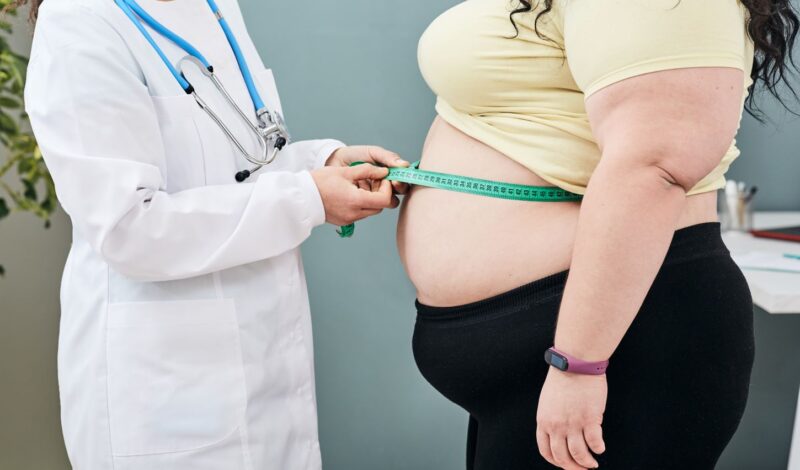The World Health Organization (WHO) has identified three different obesity levels that depend on a number of variables. The aim [...]

Calculate body fat percentage: Which values are healthy?
Body fat regulates body temperature, protects organs and tissues and is one of the most important energy stores in humans. In this respect, body fat is nothing bad, but important for your health. However, if your body fat percentage is too high, it also leads to health risks: an increased cholesterol level and high blood pressure are possible consequences. Here you can find out how to calculate your body fat percentage – and how to keep it at a healthy level.
Body fat content – what is it actually?
The body fat percentage is the amount of accumulated fat in relation to the total weight of the body. Human body functions require a certain amount of fat to function properly in the long term. This minimum value depends on sex and age. For example, women need sufficient fat reserves in case of pregnancy. For biological reasons, they therefore store slightly more fat than men. With increasing age, the body fat percentage of both sexes increases.
A healthy body fat percentage is usually between 20 and 32 percent for women and between 8 and 18 percent for men. Whether lower values are still healthy, it is not possible to give a general answer: Those who are only just above the recommended minimum values due to a sporty lifestyle and a low-fat diet can be absolutely fit – those who, on the other hand, are only 7 percent of body fat due to months of fasting risk their health. It is therefore always important how exactly the values are calculated.
How can the body fat percentage be measured?
There are several methods to measure the ratio of body fat and weight. They differ significantly in terms of effort, cost and reliability. A simple mechanical balance does not allow conclusions to be drawn about the body fat percentage. And unlike the BMI (Body Mass Index) there is no reliable formula with which you can quickly calculate the relation of total mass to body fat.
Measuring methods
Fat has a lower density than muscles and bones. A high fat content therefore increases the body volume. For this reason, hydrostatic weighing takes place in a special water basin. The ratio of the displaced water to the body weight provides information about the body fat content. The hydrostatic method is regarded as one of the most precise, but also cost-intensive methods for determining body fat.
Bioelectric impedance analysis (BIA) works with alternating current. It uses the fact that fat has a higher electrical resistance than muscles and therefore conducts electricity less effectively. The result of this alternating current measurement can, however, be falsified by many factors: Food and fluid intake, physical activity or the female cycle influence the measurement. For a reliable result, the measuring conditions should therefore be correct. These include not eating heavy meals two hours before body fat is to be measured and not drinking alcohol in the previous 24 hours. The last sporting activity should have taken place at least 12 hours ago.
With this method you form a skin fold in different parts of your body. Using a caliper, you can then measure the thickness of this skin fold yourself: The thicker the fold, the higher the body fat percentage (the exact body fat percentage can be calculated using certain formulas into which you insert the respective measured value). In order to avoid measurement inaccuracies, it is recommended to measure at least 2 to 3 different parts of the body. For example, women form a longitudinal fold on the back of the upper arm and a vertical fold two to three centimetres next to the navel. Men fold their skin lengthwise centrally on their thighs and vertically two to three centimetres next to their navel. It is best to measure each fold three times. Then calculate the average value from the results.
Also perform the measurement on several days under the same conditions and on the same parts of the body. Since this method only considers individual measurement points, this method cannot guarantee absolute accuracy with regard to your body fat percentage. So don’t concentrate too much on the concrete result of a single measurement, but on the development of the result over time.
Too much body fat? This is how you boost fat burning
If your body fat percentage is too high, you can stimulate your fat burning with a few simple measures. The most reliable way to do this is to by eating a balanced diet and exercising regularly at the same time. In the ideal case your new nourishing way offers many nutrients, Vitamine and ballast materials to you – however somewhat fewer calories than used. In this way you create a slight calorie deficit and activate fat burning. Ideally, however, you should not only lose weight by reducing calories, but also by doing endurance sports regularly or light weight training.
You should also pay attention to your intestinal flora: A healthy intestinal flora supports your fat burning. However, if your bacteria population in the intestine is mainly composed of Firmicutes bacteria, fat burning is probably difficult for you – because Firmicutes bacteria reveal the molecular structures of fat and sugar particularly well, which can lead to you storing more fat.
With INTEST.pro from BIOMES you get exact information about your intestinal flora. For example, you can find out whether certain bacteria in your intestines inhibit the burning of fat. In addition, you will receive tips on how to support the beneficial bacteria in your intestines by changing your eating habits.


